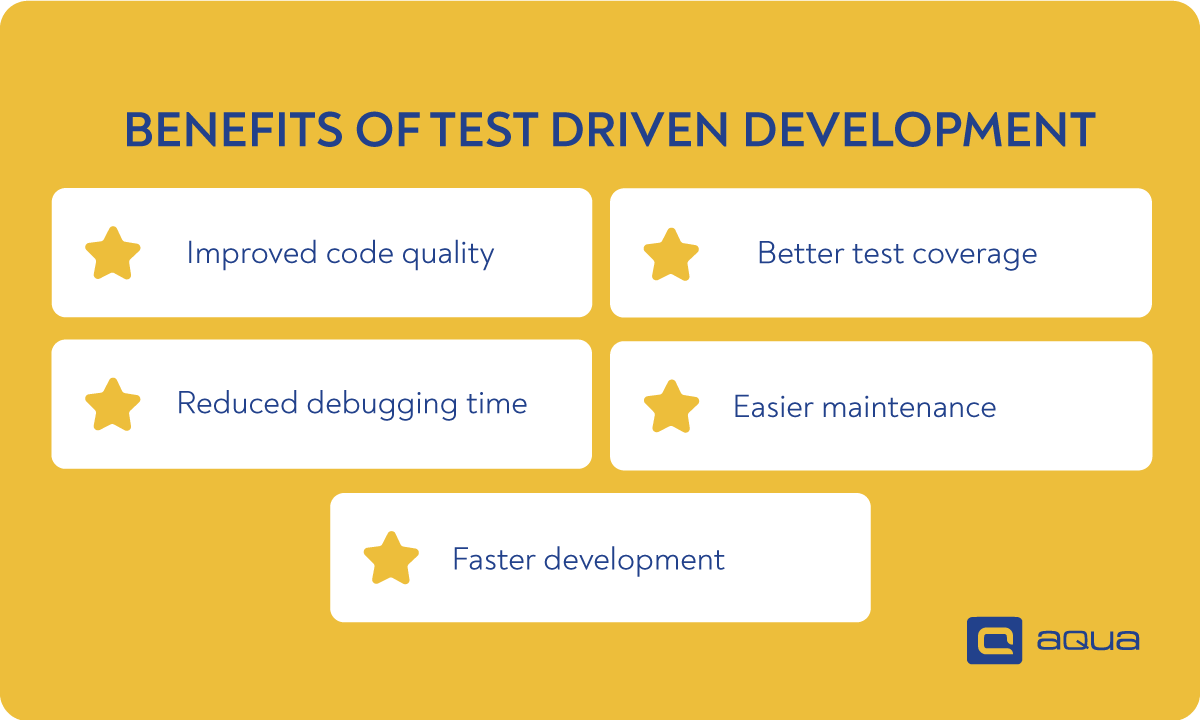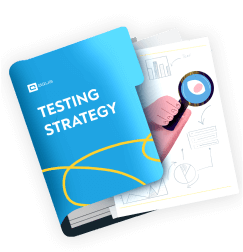TDD is a revolutionary approach to software development that can transform your code. By writing automated tests before writing code, you can catch bugs early and ensure your code is robust, efficient, and easy to maintain. But let’s not get into these specifics from the beginning. In this article, we’ll explore everything you need to know about TDD, step-by-step, from its basic principles to advanced techniques and help you decide whether this approach is worth it.
What is Test Driven Development?
Test Driven Development (TDD) is a methodology in software development that emphasises automated tests before writing the actual code. The idea is to write a failing test first that would contribute to writing the code that will pass the same test.
TDD is an iterative process that ensures your code is correct, efficient, and maintainable and meets the project’s requirements. Writing tests first allow for early bug detection, better code design, and reduced time and effort to fix bugs.
Unit testing is a crucial part of the process. In TDD, developers write unit tests designed to test individual units or pieces of code in isolation. The goal is to write tests that cover all possible scenarios and edge cases for a particular piece of code.
TDD is also closely related to Agile and is often used in conjunction with other Agile practices. The goal of Agile testing is to improve software development and deliver high-quality software continuously. By integrating TDD into an Agile testing software process, you can test and validate the software at every stage of development, which leads to better quality code and a more efficient development process.
The Process of TDD
Here’s an overview of how to do Test Driven Development:
- Write a failing test: In TDD, you should start by writing a failing test that covers specific functionality or a project requirement.
- Write minimal code to pass the test: The next step is to write the minimum amount of code required to pass the test. The code should meet test requirements but may not be the final solution.
- Improve the code: Once the test passes, you should refactor the code to make it more efficient, maintainable, and adherent to best practices.
- Repeat: Repeat this three-step process until all project requirements are met, all tests pass successfully, and the code is reasonably polished and efficient.
Following this iterative process, you can achieve high-quality, easily maintainable, testable code that meets the project’s requirements. TDD is an essential practice for Agile software development, as it enables you to quickly and efficiently develop software that meets the project’s changing needs.
"If you're happily slamming some code together that more or less works and you're happy never looking at the result again, TDD is not for you."
Benefits of Test Driven Development
There are several significant benefits of Test Driven Development, including:
- Improved code quality: Writing tests before the actual code helps identify and fix issues early, reducing the likelihood of bugs in the final product.
- Better test coverage: TDD requires developers to write tests for all possible scenarios, which leads to better test coverage and, ultimately, less risk for bugs.
- Reduced debugging time: Catching errors early in the development process significantly reduces the time and effort you put into debugging.
- Easier maintenance: Code written with the TDD approach is often more modular and easier to maintain, as it is designed to be testable and refactorable.
- Faster development: TDD can also speed up development time, as it reduces the time required for debugging and ensures that the code meets the project’s requirements.

Disadvantages of Test Driven Development
There are also some potential Test Driven Development disadvantages you should know. Here are a few:
- Time-consuming: In the TDD workflow, the need for many written tests can slow down the development process and may not be suitable for projects with tight deadlines.
- Learning curve: TDD requires learning new skills and techniques that take time to master, including test writing, automation, debugging, and code refactoring. This may result in a steep learning curve, especially for less experienced developers, leading to frustration and discouragement initially. They will, however, increase attention to detail and enhance problem-solving skills in the long term.
- Need for extra communication: TDD workflow also requires extra communication between devs and testers. The development team gets involved in the testing process and has a lot to learn from the QA team and has to wait inevitably for their responses to complete testing.
- Over-reliance on tests: Focusing more on writing tests than developing the actual software can lead to over-reliance on tests. It can cause a situation where tests are passing, but the software no longer meets the user’s needs.
- Difficulty with legacy code: TDD can be difficult to implement with legacy code or when the requirements are poorly defined. In such cases, it may be necessary to write tests after the fact, which can be time-consuming, difficult, and not in the spirit of TDD.
- Maintenance overhead: TDD can result in many tests that need maintenance over time. This can be a significant overhead, especially if the requirements of the project change frequently.
Looking to enhance your testing strategy and make the most out of TDD, BDD, or any other methodology? aqua’s testing strategy template has got you covered. With a pre-built template and the context behind it, you can quickly lay out the best approach for your project and start creating tests that meet your needs. This template covers everything from test planning to test execution and reporting, allowing you to streamline your testing efforts and determine the best tools for your strategy along the way.

Try aqua's testing strategy template to determine the testing approach that fits you the most
TDD vs BDD
Test-driven development vs BDD (Behavior Driven Development) is a common comparison when choosing a software development approach. TDD is more focused on the code and its functionality, while BDD is more focused on the system’s behaviour and user needs. BDD can help facilitate better communication between developers, testers, and business stakeholders, while TDD can provide a more granular approach to testing individual code units.
TDD vs traditional development
When it comes to the comparison between TDD and traditional development, there are some major differences you should consider. TDD involves writing tests before writing the code, while traditional development involves writing code first and testing it afterwards. TDD helps catch errors early, improve code design, and reduce the time and effort required to fix bugs. Traditional development can be more prone to errors, as testing is often an afterthought.
Common misconceptions about TDD
Here are some common misconceptions about TDD:
- TDD is only for small projects: You can use TDD on projects of any size, including complex projects with changing requirements and frequent priority shifts.
- TDD replaces the need for manual testing: TDD complements manual testing but does not replace it. It can catch errors early and ensure code quality, but manual testing is still important to catch issues automated tests miss.
- TDD results in overly complex code: TDD encourages simple, modular code that is easier to maintain and modify. Writing tests first allows developers to think about the code design and create more concise code.
- TDD is only for experienced developers: Although TDD may be more challenging for less experienced developers, it is also a useful tool for learning good coding practices and improving code quality.
Example of TDD
Here is an example of TDD programming in action:
1. Let’s say we want to create a function that sums two numbers. First, we should write a failing test that can be summarised like this:
// Test Case 1: The sum function adds two numbers
test(“sum function adds two numbers”, () => {
expect(sum(2, 3)).toBe(5);
});
Since the “sum” function is not implemented, this test will fail.
2. Then, we implement the function to pass the test case:
function sum(a, b) {
return a + b;
}
3. We add test cases to cover different scenarios:.
// Test Case 2: The sum function handles negative numbers
test(“sum function handles negative numbers”, () => {
expect(sum(-2, 3)).toBe(1);
});
// Test Case 3: The sum function handles zero
test(“sum function handles zero”, () => {
expect(sum(5, 0)).toBe(5);
});
These new test cases verify that the “sum” function handles negative numbers and zero correctly.
4. We refactor and improve the function (optional): At this stage, if you feel the need to refactor or improve the “sum” function’s implementation, you can do so while ensuring that all the existing test cases continue to pass.
5. We repeat the process for any new requirements or edge cases: As your code evolves or new requirements arise, you can follow the same TDD process of adding a failing test, implementing the corresponding functionality, and ensuring all previous tests pass.
Conclusion
In conclusion, Test Driven Development is a software development approach that ensures that the code is correct, efficient, and maintainable and that it meets the requirements of the project. TDD is already a popular practice among developers who want to write high-quality code efficiently. While TDD may have some challenges, such as a steep learning curve and a time investment upfront, its benefits to the software development process far outweigh the drawbacks.
If you’re interested in implementing Test Driven Development (TDD) in your software development process, aqua AI can help. Launch it while browsing a requirement and get a complete test case covering it. With this software testing tool, you can complete test case drafts, remove duplicate tests, and use AI to identify and prioritise essential tests.
Transform your testing process with aqua's cutting-edge AI-powered testing platform







